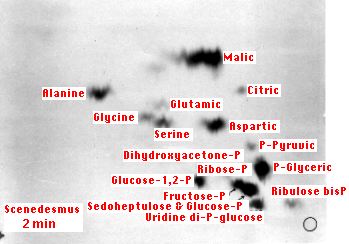Paper Chromatography
This technique provides an easy way to separate the components of a mixture.

- A drop of mixture is placed in one corner of a square of absorbent paper.
- One edge of the paper is immersed in a solvent. (a)
- The solvent migrates up the sheet by capillary attraction.
- As it does so, the substances in the drop are carried along at different rates. (b)
- Each compound migrates at a rate that reflects
- the size of its molecule and
- its solubility in the solvent.
- After a second run at right angles to the first (often using a different solvent), the various substances will be spread out at distinct spots across the sheet, forming a chromatogram. (c)
- The identity of each spot can be determined by comparing its position with the position occupied by known substances under the same conditions.
- In many cases, a fragment of the paper can be cut away from the sheet and chemical analysis run on the tiny amount of substance in it.
If the mixture contains molecules that have been labeled with a radioactive isotope, these can be located by placing the chromatogram next to a sheet of x-ray film.
The location of dark spots on the developed film (because of radiation emitted by the isotope) can be correlated with the position of the substances on the chromatogram.
An Example
The figure (courtesy of Dr. James A. Bassham) shows autoradiograms of the type that were essential in working out the dark reactions of photosynthesis.
The dark spots show the radioactive compounds produced
- after 10 secs (top) and
- 2 minutes (bottom)
of photosynthesis by the green alga Scenedesmus. The alga was supplied with carbon dioxide labeled with 14C, a radioactive isotope of carbon.
- At 10 seconds, most of the radioactivity is found in 3-phosphoglyceric acid ("P-Glyceric").
- At 2 minutes, phosphorylated 6-carbon sugars (glucose and fructose) have been synthesized as well as a number of amino acids.
The small rectangle and circle (lower right-hand corners) mark the spots where the cell extract was applied.
| Links to two other chromatographic methods
|
30 October 2022




